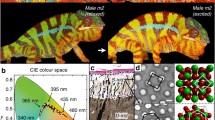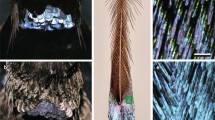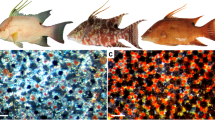Summary
The cells that form the reflecting layer beneath the chromatophore organs of the octopus are conspicuous elements of its dermal chromatic system. Each flattened, ellipsoidal reflector cell in this layer bears thousands of peripherally radiating, discoidal, reflecting lamellae. Each lamella consists of a proteinaceous reflecting platelet enveloped by the plasmalemma. The lamellae average 90 nm in thickness and have variable diameters with a maximum of about 1.7 μm. Sets of reflecting lamellae are organized into functional units called reflectosomes. The lamellae in each reflectosome form a parallel array - similar to a stack of coins. The average number of lamellae in a reflectosome is 11. Adjacent lamellae are uniformly separated by an extracellular gap of about 60 nm in embedded specimens. The reflectosomes are randomly disposed over the surface of the reflector cell.
The observed organization of the reflectosome is compatible with its role as a quarter-wave thin-film interference device. The alternating reflecting lamellae and interlamellar spaces constitute layers of high and low refractive indices. Using measurements of the thicknesses and refractive indices of the platelets and interlamellar spaces, we have calculated that the color of reflected light should be blue ⊔reen, as seen in vivo.
The sequence of events leading to the definitive arrangement of the reflectosomes is uncertain.
The reflector cells of O. dofleini are compared and contrasted with the iridophores of squid.
Similar content being viewed by others
References
Arnold, J.: Organellogenesis of the cephalopod iridophore: Cytomerabranes in development. J. Ultrastruct. Res. 20, 410–421 (1967)
Arnold, J.M., Young, R.E., King, M.U.: Ultrastructure of a cephalopod photophore. II. Iridophores as reflectors and transmitters. Biol. Bull. 147, 522–534 (1974)
Barer, R., Joseph, S.: Refractometry of Living Cells. Part I. Basic Principles. Quart. J. Micro. Sci. 95, 399–423 (1954)
Boll, F.: Beiträge zur vergleichenden Histologie des Molluskentypus. Arch. mikr. Anat. 5, (Suppl.) 1–111 (1869)
Bone, Q., Denton, E.J.: The osmotic effects of electron microscopic fixatives. J. Cell Biol. 49, 571–581 (1971)
Boyde, A.: Pros and cons of critical point drying and freeze drying for SEM. In: Scanning Electron Microscopy/1978/11 (Becker, R.P. and Johari, O. eds.) pp. 303–314. O'Hare, Ill.: Scanning Electron Microscopy Inc. (1978)
Brocco, S.L.: The fine structure of the frontal and mantle white spots Octopus dofleini. Am. Zool. 15, 782 (1975)
Brocco, S.L.: The ultrastructure of the epidermis, dermis, iridophores, leucophores and chromatophores of Octopus dofleini martini (Cephalopoda: Octopoda). Ph. D. Thesis, University of Washington, Seattle 1977
Cloney, R.A., Florey, E.: Ultrastructure of cephalopod chromatophore organs. Z. Zellforsch. 89, 250–280 (1968)
Denton, E.J.: Review lecture on the organization of reflecting surfaces in some marine animals. Phil. Trans. Roy. Soc. Lond. B. 258, 285–313 (1970)
Denton, E.J., Nicol, J.A.C.: Studies on reflexion of light from silvery surfaces of fish, with special reference to the bleak, Alburnus alburnus. J. Mar. Biol. Ass. U.K. 45, 683–703 (1965a)
Denton, E.J., Nicol, J.A.C.: Polarization of light reflected from the silvery exterior of the bleak, Alburnus alburnus. J. Mar. Biol. Ass. U.K. 45, 705–709 (1965b)
Denton, E.J., Nicol, J.A.C.: Reflexion of light by external surfaces of the herring Clupea harengus. J. Mar. Biol. Ass. U.K. 45, 711–738 (1965c)
Denton, E.J., Land, M.F.: Optical properties of the lamellae causing interference colours in animal reflectors. J. Physiol. Lond. 191, 23P-24P (1967)
Denton, E.J., Land, M.F.: Mechanism of reflexion in silvery layers of fish and cephalopods. Proc. Roy. Soc. Lond. A. 178, 43–61 (1971)
Dilly, P.N., Herring, P.J.: The ocular light organ of Bathothauma lyromma (Mollusca: Cephalopoda). J. Zool. Lond. 172, 81–100 (1974)
Fox, D.L.: Animal biochromes and structural colors. Los Angeles: University of California Press 1976
Froesch, D., Messenger, J.B.: On leucophores and the chromatic unit of Octopus vulgaris. J. Zool. Lond. 186, 163–173 (1978)
Fuchs, R.F.: Der Farbenwechsel und die chromatische Hautfunktion der Tiere. In: Handbuch der vergleichenden Physiologie (Winterstein, H. ed.), pp. 1189–1656, Jena: Fischer 1914
Girod, P.: Recherches sur la peau des céphalopodes. Arch. Zool. Exp. Gen. II. Ser. 1, 225–266 (1883)
Huxley, A.F.: A theoretical treatment of the reflexion of light by multilayer structures. J. Exp. Biol. 48, 227–245 (1968)
Kawaguti, S., Ohgishi, S.: Electron microscopic study on iridophores of a cuttlefish, Sepia esculenta. Biol. J. Okayama University 8, 115–129 (1962)
Keller, C.: Struktur der Haut der Cephalopoden. Z. Naturwiss. 10, 385–389 (1874)
Land, M.F.: The physics and biology of animal reflectors. Prog. Biophys. Molecular Biol. 24, 77–106 (1972)
Luft, J.H.: Improvements in epoxy resin embedding methods. J. Biophys. Biochem. Cytol. 9, 409–414 (1961)
Messenger, J.B.: Reflecting elements in cephalopod skin and their importance for camouflage. J. Zool. Lond. 174, 387–395 (1974)
Mirow, S.: Skin color in the squids Loligo pealii and Loligo opalescens. I. Chromatophores. Z. Zellforsch. 125, 143–175 (1972a)
Mirow, S.: Skin color in the squids Loligo pealii and Loligo opalescens. II. Iridophores. Z. Zellforsch. 125, 176–190 (1972b)
Müller, H.: Bericht über einige im Herbste 1852 in Messina angestellte, vergleichend-anatomische Untersuchungen. Zeitschrift f. wissensch. Zool. 4, 299–370 (1853)
Packard, A.: Cephalopods and fish: The limits of convergence. Biol. Rev. 47, 241–307 (1972)
Packard, A., Sanders, G.: What the octopus shows to the world. Endeavour 28, 92–99 (1969)
Packard, A., Sanders, G.D.: Body patterns of Octopus vulgaris and maturation of the response to disturbance. Anim. Behav. 19, 780–790 (1971)
Packard, A., Hochberg, F.G.: Skin patterning in Octopus and other genera. Symp. Zool. Soc. Lond. 38, 191–231 (1977)
Parker, G.H.: Animal colour changes and their neurohumors. Cambridge: University Press 1948
Rabl, H.: Über Bau und Entwicklung der Chromatophoren der Cephalopoden, nebst allgemeinen Bemerkungen über die Haut dieser Tiere. S.B. Akad. Wiss. Wien, Math.-Nat. Kl. 109, 341–404 (1900)
Reynolds, E.S.: The use of lead citrate at high pH as an electron-opaque stain in electron microscopy. J. Cell Biol. 17, 208–212 (1963)
Richardson, K.C., L. Jarett, Finke, E.H.: Embedding in epoxy resins for ultrathin sectioning in electron microscopy. Stain Technol. 35, 313–323 (1960)
Ross, K.F.A.: Phase contrast and interference microscopy for cell biologists. New York: St. Martin's Press 1967
Schäfer, W.: Bau, Entwicklung und Farbenentstehung bei den Flitterzellen von Sepia officinalis. Z. Zellforsch. 27, 222–245 (1938)
Young, R.E.: Ventral bioluminescent countershading in midwater cephalopods. Symp. Zool. Soc. Lond. 38, 161–190 (1977)
Author information
Authors and Affiliations
Additional information
This investigation was supported in part by grant 5-TO1-HD-0026 from the National Institute of Health
Rights and permissions
About this article
Cite this article
Brocco, S.L., Cloney, R.A. Reflector cells in the skin of Octopus dofleini . Cell Tissue Res. 205, 167–186 (1980). https://doi.org/10.1007/BF00234678
Accepted:
Issue Date:
DOI: https://doi.org/10.1007/BF00234678




